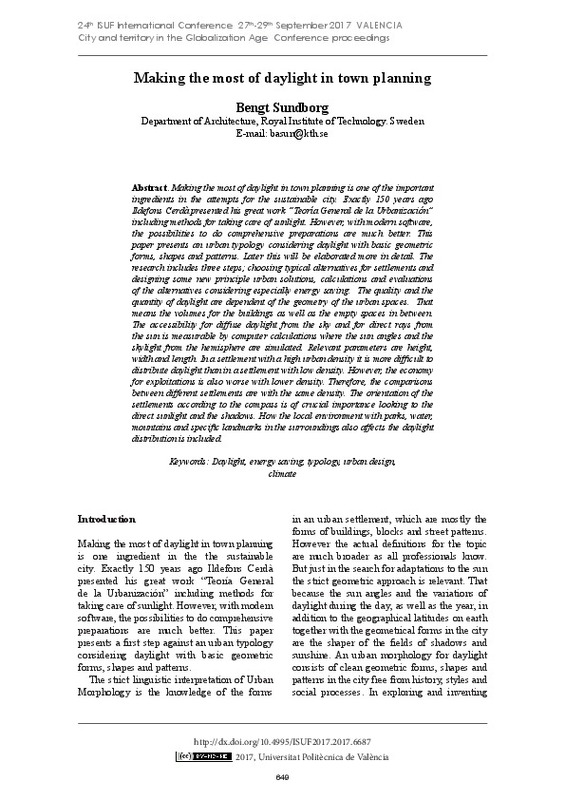JavaScript is disabled for your browser. Some features of this site may not work without it.
Buscar en RiuNet
Listar
Mi cuenta
Estadísticas
Ayuda RiuNet
Admin. UPV
Making the Most of Daylight in Town Planning
Mostrar el registro sencillo del ítem
Ficheros en el ítem
| dc.contributor.author | Sundborg, Bengt
|
es_ES |
| dc.date.accessioned | 2018-12-05T08:12:28Z | |
| dc.date.available | 2018-12-05T08:12:28Z | |
| dc.date.issued | 2018-04-20 | |
| dc.identifier.isbn | 9788490485743 | |
| dc.identifier.uri | http://hdl.handle.net/10251/113471 | |
| dc.description.abstract | [EN] Making the most of daylight in town planning is one of the important ingredients in the attempts for the sustainable city. Exactly 150 years ago Ildefons Cerdà presented his great work “Teoría General de la Urbanización” including methods for taking care of sunlight. However, with modern software, the possibilities to do comprehensive preparations are much better. This paper presents an urban typology considering daylight with basic geometric forms, shapes and patterns. Later this will be elaborated more in detail. The research includes three steps; choosing typical alternatives for settlements and designing some new principle urban solutions, calculations and evaluations of the alternatives considering especially energy saving. The quality and the quantity of daylight are dependent of the geometry of the urban spaces. That means the volumes for the buildings as well as the empty spaces in between. The accessibility for diffuse daylight from the sky and for direct rays from the sun is measurable by computer calculations where the sun angles and the skylight from the hemisphere are simulated. Relevant parameters are height, width and length. In a settlement with a high urban density it is more difficult to distribute daylight than in a settlement with low density. However the economy for exploitations is also worse with lower density. Therefore the comparisons between different settlements are with the same density. The orientation of the settlements according to the compass is of crucial importance looking to the direct sunlight and the shadows. How the local environment with parks, water, mountains and specific landmarks in the surroundings also affects the daylight distribution is included. | es_ES |
| dc.format.extent | 7 | es_ES |
| dc.language | Inglés | es_ES |
| dc.publisher | Editorial Universitat Politècnica de València | es_ES |
| dc.relation.ispartof | 24th ISUF International Conference. Book of Papers | es_ES |
| dc.rights | Reconocimiento - No comercial - Sin obra derivada (by-nc-nd) | es_ES |
| dc.subject | Daylight | es_ES |
| dc.subject | Energy saving | es_ES |
| dc.subject | Typology | es_ES |
| dc.subject | Urban design | es_ES |
| dc.subject | Climate | es_ES |
| dc.title | Making the Most of Daylight in Town Planning | es_ES |
| dc.type | Capítulo de libro | es_ES |
| dc.type | Comunicación en congreso | es_ES |
| dc.identifier.doi | 10.4995/ISUF2017.2017.6687 | |
| dc.rights.accessRights | Abierto | es_ES |
| dc.description.bibliographicCitation | Sundborg, B. (2018). Making the Most of Daylight in Town Planning. En 24th ISUF International Conference. Book of Papers. Editorial Universitat Politècnica de València. 649-655. https://doi.org/10.4995/ISUF2017.2017.6687 | es_ES |
| dc.description.accrualMethod | OCS | es_ES |
| dc.relation.conferencename | 24th ISUF 2017 - City and Territory in the Globalization Age | es_ES |
| dc.relation.conferencedate | Septiembre 27-29,2017 | es_ES |
| dc.relation.conferenceplace | Valencia, Spain | es_ES |
| dc.relation.publisherversion | http://ocs.editorial.upv.es/index.php/ISUF/ISUF2017/paper/view/6687 | es_ES |
| dc.description.upvformatpinicio | 649 | es_ES |
| dc.description.upvformatpfin | 655 | es_ES |
| dc.type.version | info:eu-repo/semantics/publishedVersion | es_ES |
| dc.relation.pasarela | OCS\6687 | es_ES |








